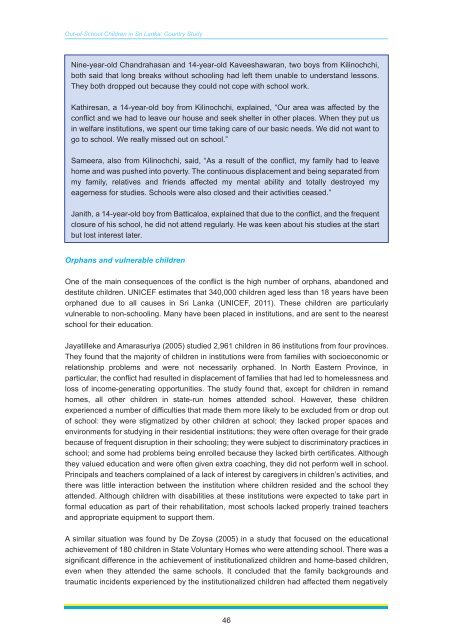Sri Lanka - Institut de statistique de l'Unesco
Sri Lanka - Institut de statistique de l'Unesco
Sri Lanka - Institut de statistique de l'Unesco
You also want an ePaper? Increase the reach of your titles
YUMPU automatically turns print PDFs into web optimized ePapers that Google loves.
Out-of-School Children in <strong>Sri</strong> <strong>Lanka</strong>: Country Study<br />
Nine-year-old Chandrahasan and 14-year-old Kaveeshawaran, two boys from Kilinochchi,<br />
both said that long breaks without schooling had left them unable to un<strong>de</strong>rstand lessons.<br />
They both dropped out because they could not cope with school work.<br />
Kathiresan, a 14-year-old boy from Kilinochchi, explained, “Our area was affected by the<br />
conflict and we had to leave our house and seek shelter in other places. When they put us<br />
in welfare institutions, we spent our time taking care of our basic needs. We did not want to<br />
go to school. We really missed out on school.”<br />
Sameera, also from Kilinochchi, said, “As a result of the conflict, my family had to leave<br />
home and was pushed into poverty. The continuous displacement and being separated from<br />
my family, relatives and friends affected my mental ability and totally <strong>de</strong>stroyed my<br />
eagerness for studies. Schools were also closed and their activities ceased.”<br />
Janith, a 14-year-old boy from Batticaloa, explained that due to the conflict, and the frequent<br />
closure of his school, he did not attend regularly. He was keen about his studies at the start<br />
but lost interest later.<br />
Orphans and vulnerable children<br />
One of the main consequences of the conflict is the high number of orphans, abandoned and<br />
<strong>de</strong>stitute children. UNICEF estimates that 340,000 children aged less than 18 years have been<br />
orphaned due to all causes in <strong>Sri</strong> <strong>Lanka</strong> (UNICEF, 2011). These children are particularly<br />
vulnerable to non-schooling. Many have been placed in institutions, and are sent to the nearest<br />
school for their education.<br />
Jayatilleke and Amarasuriya (2005) studied 2,961 children in 86 institutions from four provinces.<br />
They found that the majority of children in institutions were from families with socioeconomic or<br />
relationship problems and were not necessarily orphaned. In North Eastern Province, in<br />
particular, the conflict had resulted in displacement of families that had led to homelessness and<br />
loss of income-generating opportunities. The study found that, except for children in remand<br />
homes, all other children in state-run homes atten<strong>de</strong>d school. However, these children<br />
experienced a number of difficulties that ma<strong>de</strong> them more likely to be exclu<strong>de</strong>d from or drop out<br />
of school: they were stigmatized by other children at school; they lacked proper spaces and<br />
environments for studying in their resi<strong>de</strong>ntial institutions; they were often overage for their gra<strong>de</strong><br />
because of frequent disruption in their schooling; they were subject to discriminatory practices in<br />
school; and some had problems being enrolled because they lacked birth certificates. Although<br />
they valued education and were often given extra coaching, they did not perform well in school.<br />
Principals and teachers complained of a lack of interest by caregivers in children’s activities, and<br />
there was little interaction between the institution where children resi<strong>de</strong>d and the school they<br />
atten<strong>de</strong>d. Although children with disabilities at these institutions were expected to take part in<br />
formal education as part of their rehabilitation, most schools lacked properly trained teachers<br />
and appropriate equipment to support them.<br />
A similar situation was found by De Zoysa (2005) in a study that focused on the educational<br />
achievement of 180 children in State Voluntary Homes who were attending school. There was a<br />
significant difference in the achievement of institutionalized children and home-based children,<br />
even when they atten<strong>de</strong>d the same schools. It conclu<strong>de</strong>d that the family backgrounds and<br />
traumatic inci<strong>de</strong>nts experienced by the institutionalized children had affected them negatively<br />
46

















